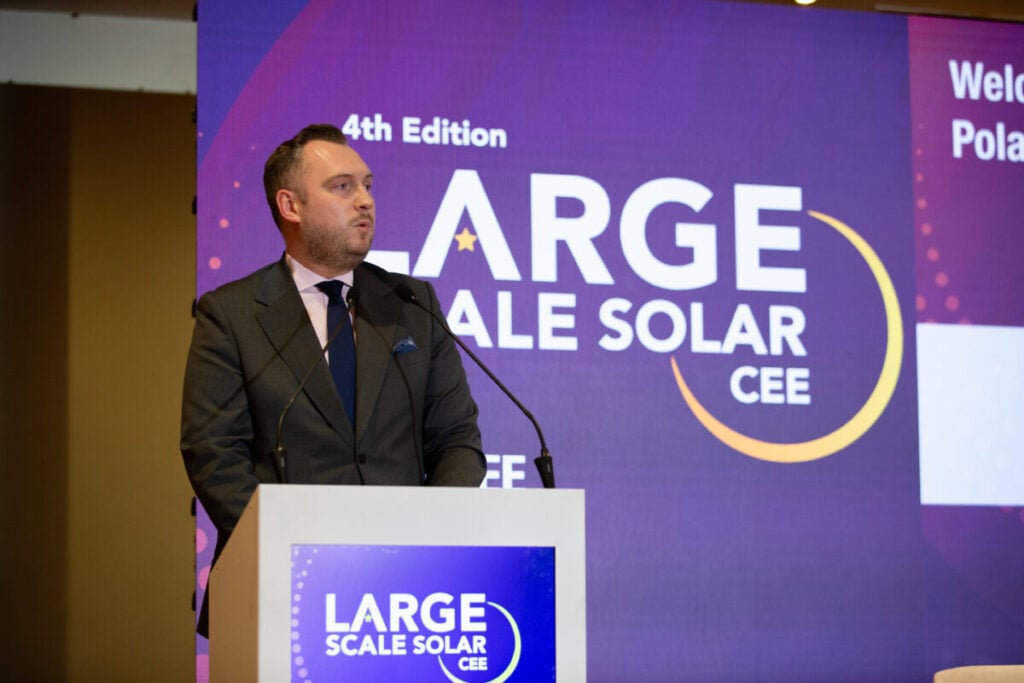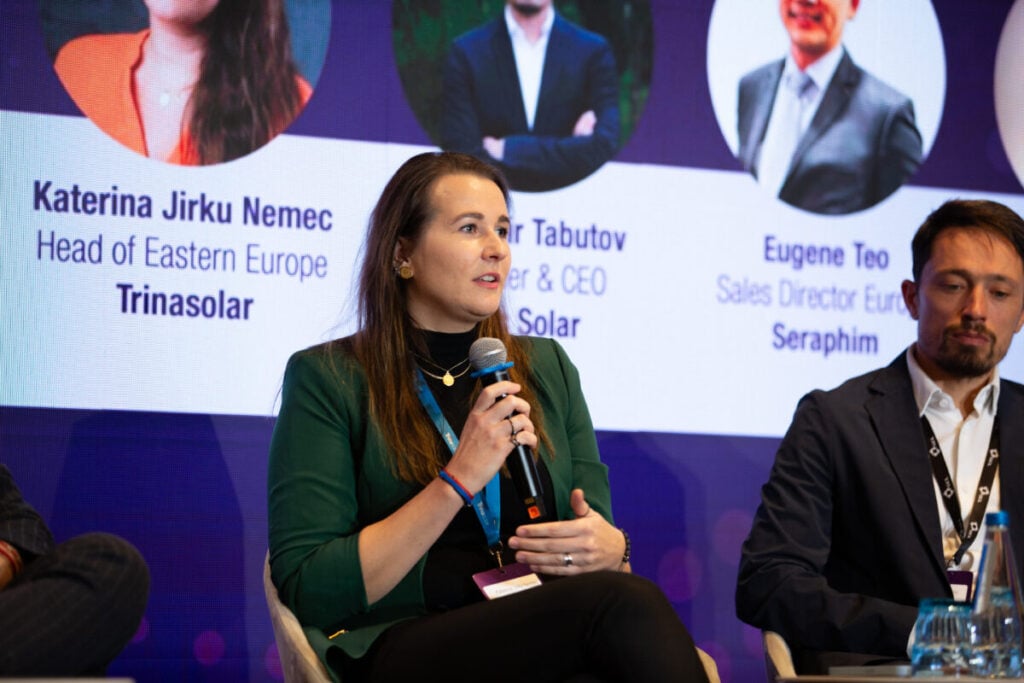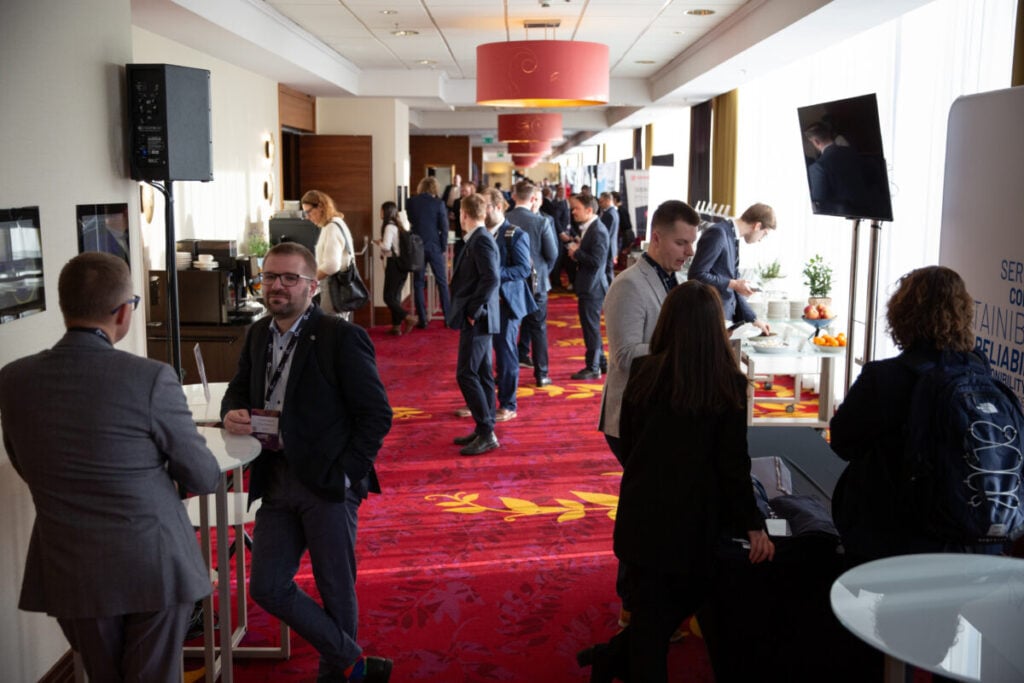Grid challenges and storage potential in a maturing Eastern European solar market
November 28, 2024
September saw the country’s coal sector provide less than half of the country’s electricity generation for the first time in history, according to the undersecretary, and October saw renewable power, driven by solar, account for 30% of the country’s electricity generation, developments that Wojnarowski called a “breakthrough” for the country’s renewable power sector.
“The national development strategy [defines] – after consultation with ministries, organisations, entrepreneurs and society, of course – the basic conditions, objective and directions of the country’s development in social, economic and spatial dimensions over a period of ten to 15 years,” said Wojnarowski, of the government’s plans to build on this recent growth.
The undersecretary’s speech touched on a number of topics that would be discussed in greater depth later during the conference: the importance of batteries in tackling grid challenges, the need to engage private investors in the Eastern European solar sector and how risk can best be managed in a high-potential industry.
Grid capacity remains a key challenge
The rapid pace of growth in the Eastern European solar sector has created challenges for the region’s energy infrastructure, and speakers and attendees alike expressed concern about how best the region’s grids can tackle this recent uptick in solar generation.
These concerns are borne out in the figures for some of the region’s largest electricity grids. In Poland, transmission system operator (TSO) Polskie Sieci Elektroenergetyczne had curtailed 13GWh of solar generation alone as of May this year, while the Bulgarian Association for Production, Storage, and Trading of Electricity reported a 35GW pipeline of new solar and wind capacity awaiting for grid connection as of August 2023.
At a panel on grids, speakers discussed alternative technological options to alleviate grid connection issues – including the addition of more storage capacity – and greater awareness of the priorities of other actors in the sector. Robin Hirschl, CEO of financier PV-Invest, said that the current means of assessing the value and production of energy production, distribution and storage is lacking, and that “the whole market needs to be a bit more intelligent.”
“We are ready, and we are 100% convinced that we need to move away from this stupid megawatt-hours [approach] to more intelligent systems, that includes batteries, that might include electrolysers, green hydrogen [and] forecasting models [so] that we have the right energy balancing in both directions,” said Hirschl.

“In the last 45 minutes I have revised, a bit, my opinion about grid operators,” Hirschl added; by speaking on a panel comprised of himself and three grid operators, he expressed a newfound respect for grid operators to engage with technologies, such as storage, and consider new ways of working to alleviate grid capacity issues.
“I always thought you guys are the dinosaurs, that you’re holding up innovations; this is obviously not the case!”
These new grid projects will require significant investment in the coming years. The National Energy and Climate Plans (NECPs) of Slovenia, Bulgaria and Romania call for €4.6 billion, €1.6 billion and €800 million, respectively, of new grid investments before 2030, and a report from Lithuanian market research firm Seenext expects Romania and Croatia to invest an additional €1.4 billion and €800 million, respectively, in grids by the end of the decade.
Storage to alleviate grid issues
Despite the scale of the grid challenges and the capital that could be required to tackle them, speakers, both on stage and in private conversations, expressed optimism that a greater integration of storage technologies across Eastern Europe could alleviate some of these grid challenges.
The storage sector has grown rapidly in recent years, with figures from the Polish Energy Regulatory Office showing that the country’s network of distribution system operators (DSOs) and TSOs currently boast 1.46GW of batteries, split across 12 facilities. A number of auctions have been held to add significantly more capacity to the grid, with contracts concluded for 9.5GW of batteries.
“You can diversify your products, the electricity products that you purchase on the market,” said Magdalena Hilgner, head of energy department at Polish telecoms company PLAY, who told PV Tech Premium exclusively that, as an offtaker, projects with co-located storage components are becoming an increasingly attractive investment destination, despite their relatively high price compared to renewable power projects.
“To us, battery energy storage systems (BESS) are too expensive for now,” said Magdalena. “But I hope that it’s the same as electric cars; it’s going to be commercialised and popular, the technology is going to become cheaper and more available.
“Three years ago, batteries were like a story that you were talking about: ‘maybe something will be happening in this area’. [Change] happens in front of our eyes; it’s so fast that everyone wants to have one, like a new iPhone!”
Retrofits and EPC opportunities
Considering the price of battery projects, and the impact that co-locating a storage system with a PV system can have on capex, other speakers suggested that there could be a wave of interest in adding batteries to renewable energy projects that have already been in operation for some time.
“There may be a trend of retrofitting existing PV installations with batteries,” said Miłosz Gliński, executive director of global debt financing at Santander Corporate & Investment Banking. “It’s not going to happen yet … but it’s going to happen as it simply makes sense. We think the market in Poland will start with standalone, then greenfield co-located, then retrofits.”
“You want to be ready for every eventuality,” added Josh Murphy, head of energy storage at independent power producer (IPP) Econergy Renewable Energy, who suggested that considering the uncertain market and regulatory conditions in a number of countries across Europe as a whole, investing in a range of technologies and means of teaming storage with renewable power generation would be of benefit.
“Prepare for everything,” said Murphy. “You ask your grid connection operator for import capacity, as well as export capacity; you try to plan for every single eventuality [and] whatever comes out, you plan your project for it.”

Further downstream, Katerina Jirku Nemec, head of Eastern Europe at Chinese manufacturing giant Trinasolar, suggested that the greater integration of storage could improve the resilience of the Eastern European supply chain.
“In terms of battery storage, we see a big opportunity for local engineering, procurement and construction companies (EPCs), for instance, to help with integration, as we see battery storage producers from China, and elsewhere, may not have the manpower in terms of commissioning,” said Nemec, an important opportunity for local EPCs considering that the solar sector in particular is still reliant on products made in China.
“That’s why, as Trina, we’re seeking partners all over Europe, and all over Eastern Europe, who will partner with us to be our partners, not just our customers. This is the way that we can overcome the [supply chain] situation and turn it into opportunities.”
Market maturation and committing capital
The relative financial maturity of the Polish market compared to its Eastern European neighbours was also a topic of conversation, with one panel discussing the need for projects in the region to demonstrate their financial viability and reach the “ready-to-bank” stage.
Maciej Kowalski, CEO of Ignitis Renewables, a state-owned Lithuanian utility, described the Polish market as having “positive aspects” compared to others in Eastern Europe, while Tomasz Sawicki, director of structured finance at IPP R. Power, said that the first round of capacity auctions in Romania, held earlier this month, were “less developed” and “less prospective” than the market in Poland.
“I would say every market is different – every market has its own opportunities and challenges – but definitely what I can say is that the Polish market is the most complex and the most competitive, from a different point of perspective, starting with development and going towards PPAs and so on,” added Lukasz Witkowski, managing director of renewable energy company Better Energy Poland.

“This is really challenging, but has the greatest potential, I believe,” continued Witkowski, who was one of several attendees to discuss the role of PPAs in the financial landscape.
There is also the idea that the Eastern European renewable power sector will simply need more investment, and investors that are more willing to commit to larger-scale projects. Speaking about storage in particular, Hirschl suggested that investors should be committing more to the energy transition.
“The next ones that I’m going to blame for being dinosaurs are the banks and lenders who need to finance our systems!” Hisrchl said. “They need to be convinced that you can have a grid business case even if you don’t know exactly how many megawatt-hours you can inject and at what price.”
Working with risk
This idea of committing significant capital, even though there are uncertainties as to the specific returns on these investments, is obviously one that would unsettle many investors, but one that was discussed at length at the final panel of the first day, in which a number of debt and equity investors discussed the impact of risk on Eastern Europe’s solar sector.
“If we run the numbers on what is the top spot … in any kind of discussion involving banks, I think that award would go to the word ‘risk’,” said Ewelina Szulc, managing director of IPP Klara Renewables, who moderated the panel.
“Most of the risks that are hot topics have been discussed today,” agreed Ewa Banasiuk, head of renewable energy and project finance at DNB Bank Poland, and one of the panellists. Banasiuk said to PV Tech exclusively that the combination of high perceived risk and high potential returns means investors may need to recalibrate what they consider to be an acceptable level of risk when investing in the space.
“The necessity to deliver the energy transition remains valid, but the cost of it needs to be constantly reassessed in the changing and at times unpredictable environment,” Banasiuk told PV Tech Premium. “And the risks are sometimes underestimated under the competitive pressure. Both investors and financing institutions need to reevaluate the levels but also the types of risks on an ongoing basis. We see some attempts to risk mitigation, for example through taking a portfolio approach.”
Appetite for investment
Ultimately, and encouragingly for the Eastern European solar sector, many of these challenges have not dissuaded investors from providing finance for the industry that will need additional financial support to meet both solar and storage deployment targets.
Anastasia Gurnell, associate of structured finance origination at investment bank Nord/LB, said that, provided each investment can be structured in such a way as to manage their “risk profiles”, the sector will continue to attract finance.
“Nord LB has an appetite for merchant risk … for us it just means that you have to structure the deal slightly differently,” said Gurnell. “So, for example, we can do things … where we can finance [a project] through construction over quite a short tender, to enable the discussion around PPAs to occur once a project has already absorbed some of that construction risk; or, if the intention is to sell it, allows the project to finance itself and then be sold on when it’s materially past some of those construction risks.”
“We need to link all this to available sources of funding, both national and European, as well as engage private capital,” said Wojnarowski, highlighting the vital role of securing finance for all of these projects in his opening speech. “Creating the conditions for a competitive and equitable economy that respects the environment and the climate will [drive] energy transformation.”
Search
RECENT PRESS RELEASES
Related Post



